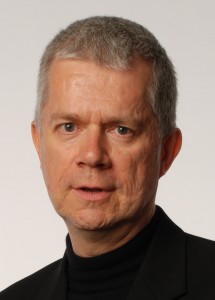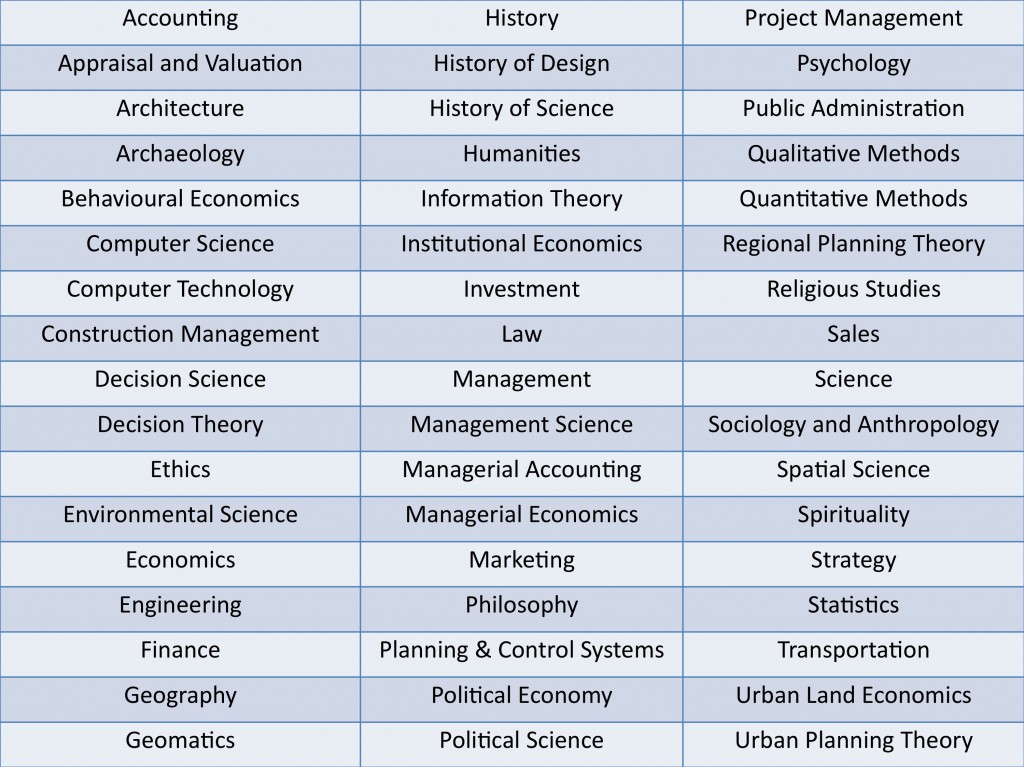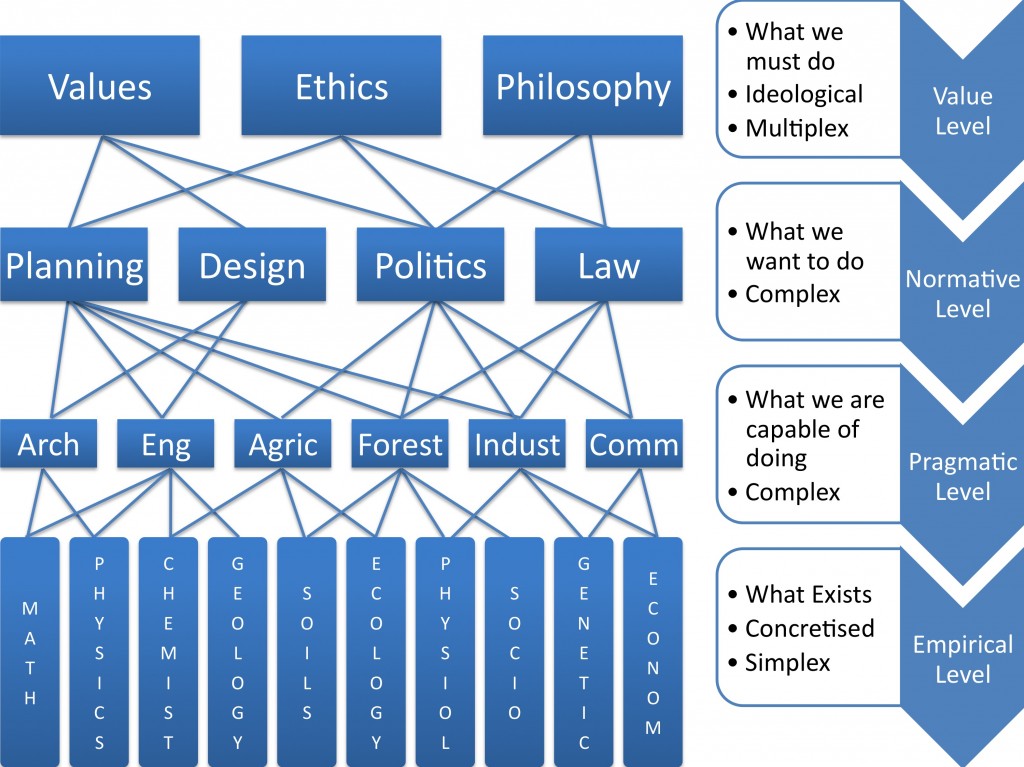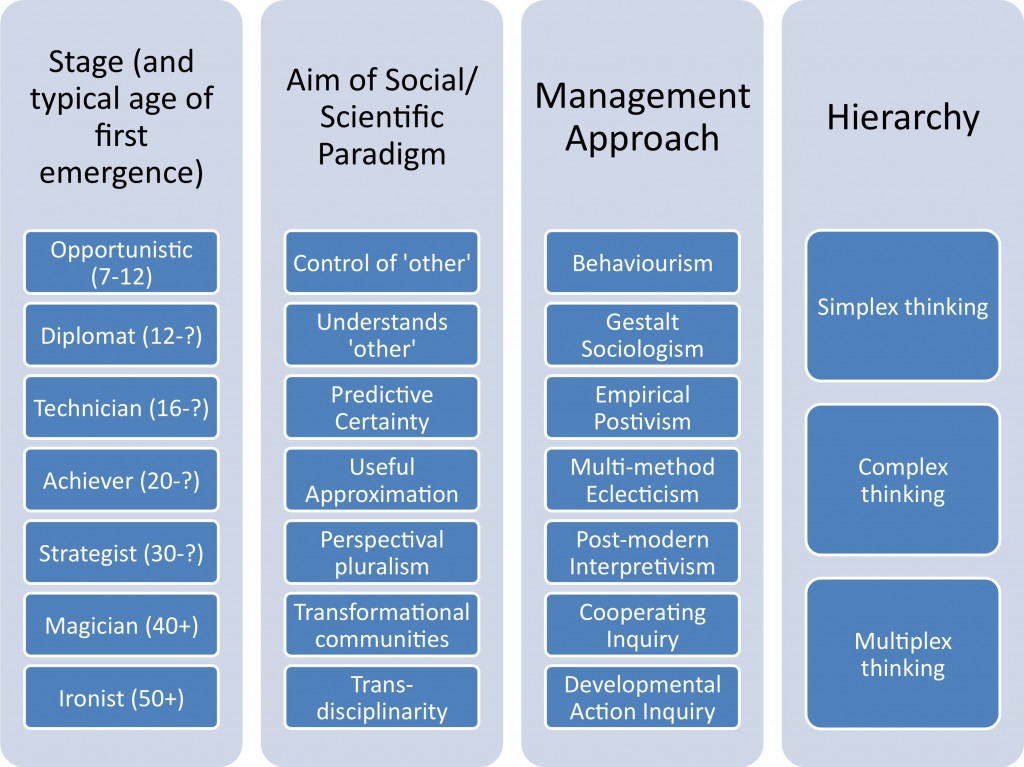Michael McDermott and Spike Boydell
ABSTRACT
An intellectual foment has been under way for the last few decades, with the limitations of modernist scientism and similarly mechanistic philosophies being revealed as fraudulent insofar as they make claims to any magisterial authority—in particular, over life and social sciences. The ground is shifting beneath our conceptual feet, and with it notions of our rights over the ground itself.
Central to the emerging paradigm is the co-evolutionary emergence of complexity epistemology (the study of emergent levels of knowing) and complexity axiology (the study of emergent levels of valuing), and pivotal to these are the concepts of self and identity creation (which is the literal meaning of ‘autopoiesis’, and the understanding we are using in this paper). We are referring to autopoiesis at all relevant scales, and in particular at both individual and social scales. Ecological niches are both found and created by that autopoietic process, and are grounded in the forms of rights over real property that a particular society evolves to satisfy its needs at a given moment in time. They are often co-dependently internalised into the identities of members of that society in mutual interest social contracts: ‘this land belongs to me; this land is a part of me’.
There are few areas where these issues are as apparent as in land policy. With the aim of better formulating land policy advice, this paper is an attempt towards the construction of an axiological (valuational) framework whereby the effects of changes in real property rights can be qualitatively as well as quantitatively assessed. These changes are registered not only as economic values, as endemic in mechanistic philosophies, but also in terms of social and environmental values. While an axiological approach is clearly impossible within mechanistic philosophical frameworks that ‘encourage assumptions that intelligence is objectively measureable and culture-transcendent’ (Cohen, Ambrose and Powell 331), the approach appears possible within the much larger hierarchical framework of complexity epistemology, complexity axiology, and transdisciplinarity.
1. COMPLEXITY AND TRANSDISCIPLINARITY
In 2009, the University of Technology Sydney launched the transdisciplinary Asia-Pacific Centre for Complex Real Property Rights (UTS: APCCRPR – see www.dab.uts.edu.au/apccrpr). The transdisciplinary approach of the UTS: APCCRPR recognises that the challenges of contemporary real property rights can not be resolved by a single, or even multi-, disciplinary approach. Real property rights are complex, and in combining this reality from a transdisciplinary perspective, ‘complexity is a modern form of the very ancient principle of universal interdependence’ (Nicolescu 153).
In this paper we explore aspects of our emergent philosophy for the Centre while using as our lens a project that explores the landscape of real property rights. Central to this project is the lived experience of the land policy adviser, an analysis of the roles and perceptions of the multiple stakeholders involved in aid funded land policy interventions in developing countries, and the development of a hybrid model/toolkit/framework for land policy and property rights projects that draws on a complexity epistemology, complexity axiology, and transdisciplinary thinking (at its many levels).
Whilst engagement with transdisciplinary thinking is not new within the University of Technology, Sydney where it has been practised with some significant success at the Institute for Sustainable Futures (the focus of a recent article in this journal by Volckmann and McGregor), the approach taken at the APCCRPR is the first example of its application to real property rights and land policy issues. This paper builds on our earlier research on Institutions, Complexity, and the Land (see Boydell “Institutions, Complexity, and the Land”).
2. THE LAND POLICY CHALLENGE
Within any land policy intervention there are multiple stakeholders. These range from government, citizenry and landholders in a country seeking aid support to the taxpayers, policy advisers and ministers in the donor country. At the interface between donor and recipient there is often a raft of consultants who are contracted to deliver parts of the project. These consultants are usually recruited for their disciplinary expertise and their track record in the timely delivery of similar projects elsewhere around the globe.
As Caulfield ( 235) identifies in her analysis of World Bank projects, career consultants have to ‘close their eyes to certain aspects of the real world’. She suggests that the most successful consultants have learned to narrow their vision to only their small piece of the puzzle, so that they can complete their tasks quickly and efficiently before moving on to their next mission. The implication here is that those who attempt to look at the big picture are not popular teammates, particularly as they run the risk of exposing the futility (at the operationalised or concretised level) of some otherwise ideologically well-intentioned land policy interventions. Our long-term aim is to explore how we can offer guidance to ensure that the players/stakeholders better understand the holistic nature of real property rights and land policy.
3. ENGAGING AN HOLISTIC APPROACH
So what are starting points that can guide the evolution of such a philosophy? We know that to achieve a holistic model that engages with the complexity of real property rights will require strong transdisciplinarity, meaning that it goes much deeper into the realms of reality (Max-Neef 10). Disciplinarity is specialisation in isolation, which is the level of most academic knowledge production at present (Miller et al.). Multidisciplinarity assumes a situation where there may be many consultants who, drawing on Caulfield’s example above, are looking at their individual pieces of the puzzle from their respective disciplinary perspectives without evident cooperation. Pluridisciplinarity is demonstrated where there is a level of cooperation between consultants without clear coordination or stimulus to promote this cooperation. Interdisciplinarity can be achieved when there is coordination from a higher level concept, but can result in what Healy refers to as ‘epistemic sovereignty’. The difficulty that has to be overcome in our approach is that such epistemic sovereignty is ‘central to the assumed pre-eminence of vision that underpins conventional notions of globalism, and of the capitalism underpinning it’ (Healy 700).
Our aspirations for an integrated research approach with applied policy outcomes is motivated by the realisation that ‘ any single way of knowing is insufficient for understanding the complexity of the world’ (Miller et al. 46). Epistemic sovereignty runs counter to such pluralist understandings that require an emphasis on equity, difference, diversity, practices and choice. Moreover, it is inaccessible to specialists per se as long as they are so confined, and only accessible to generalists through a great deal of personal development. It is more than just a new discipline or super-discipline; it requires ‘a different manner of seeing the world, more systemic and more holistic’ (Max-Neef 15).
Figure 1: Fundamental Disciplines for Real Estate Involvement (Boydell “Disillusion, Dilemma, and Direction: The Role of the University in Property Research”, adapted from Roulac)
In an earlier paper (Boydell “Disillusion, Dilemma, and Direction: The Role of the University in Property Research”) we argued that the vocational nature of property and land professionals necessitates their engagement in a diversity of fundamental disciplines (see Figure 1). This grounding suggests that property and land professionals are well placed to see the limitations of single discipline approaches and also gives the breadth, and potentially the depth, of understanding of transdisciplinarity to be able to lead complex land policy and real property rights projects.
4. HELPFUL HIERARCHIES
Importantly, these disciplines are not all of the same epistemological ‘level’. This is well articulated by Max-Neef in his exposition of transdisciplinarity being the coordination between all hierarchical levels (see Figure 2). We have drawn on a similar analysis that engaged a hierarchy that spanned from the abstract (where Max-Neef places values, ethics and philosophy) down to the concretised (where Max-Neef refers to what exists in the physical laws of nature and the principles that drive the life and societies) in our ongoing work on carbon property rights (Boydell et al.), which has been influenced by the concept of constellation articulated by Franz von Benda-Beckmann et al. from the legal pluralism group of the Max Planck Institute for Social Anthropology (von Benda-Beckmann, von Benda-Beckmann and Wiber).
Figure 2: Transdisciplinarity Hierarchy (adapted from Max-Neef; von Benda-Beckmann, von Benda-Beckmann and Wiber; Stewart and Cohen)
“Transdisciplinarity concerns itself with what is between the disciplines, across the different disciplines, and beyond all disciplines” (Nicolescu 143). Nicolescu highlights the importance of recognising that there is a theoretical transdisciplinarity (implying a well-defined methodology), phenomenological transdisciplinarity (implying building models to connect theory to observed reality to predict further), and experimental transdisciplinarity (allowing experimentation using a procedure that will enable research design to be replicated). Accepting simultaneous and rigorous consideration of these three aspects simultaneously will allow the huge potential of transdisciplinarity to be realised.
Applying this insight to land policy, as well as more general policy formulation, we realise that transdisciplinarity will enable us to unfold consideration of how much attention disciplines pay to processes instead of simply things. It will involve qualitative assessments of the transdisciplinary contributions on the basis of their intrinsic value in relationship to their extrinsic value. We will then need to assess these to match what is required in a particular situation. This will enable us to reflect on, and develop, land policies—including real property rights frameworks—that are tailored to the unique qualities of the environments and influences of a particular situation/country/stage of development. Combining this with complexity theory will “maximise robustness…in the face of an ill-defined future. And that, in turn, puts a premium on becoming aware of non-linear relationships and causal pathways as best we can. You observe the world very, very carefully, and you don’t expect circumstances that last’ (Arthur, interviewed in Waldrop 333-4).
As a first step toward a complexity epistemology, Stewart and Cohen divide cognition levels into simplex, complex, and multiplex. Whilst we may all be simplex in different domains, we are not implying that an individual would have ‘nothing but’ a simplex mind. Whilst simplex minds can be of great extrinsic value, they have a less intrinsic value in themselves than those with insights into the complexities of real life with an appreciation of and ability to manage transdisciplinarity. Meanwhile, a complex mind ‘can perceive the many intertwining strands of cause and effect that combine, within some consistent worldview, to control the unfolding of a particular selection of events’ (Stewart and Cohen 289). Those who have achieved holistic multiplex awareness can work simultaneously with several competing paradigms, seeing ‘not just one interpretation of reality but many as a seamless whole in a mutable, adaptive, loosely coherent flux’ (ibid). Such hierarchies have similarly been identified and categorised by Wilber. Once again, the evolution of the individual’s ability to transcend a hierarchy from simplex, through complex, to multiplex requires a certain level of maturity, which can be usefully integrated with Torbert’s developmental management structure (see Figure 3).
Figure 3: Development Management Structures and Hierarchy (adapted from Torbert; Stewart and Cohen)
As far as we are aware, there has been little empirical research as yet that investigates real property rights through similar schemata. A useful conceptual framework has been posited by Beck and Cowan, which has yet to be fully hybridised with the above approaches (see Figure 4). This framework is filled by v-memes (values attracting meta-memes). As what you value drives what you want to know, values drive knowledge. Knowledge then informs values, and they co-evolve in mutual feedback. Such processes are stimulated by environmental challenges of manageable proportions (Csikszentmihalyi). If all goes well, these processes result in progressive emergences into whole new levels of understanding. Beck and Cowan submit that their v-memes are stations along that ascending path, which we submit is one of the co-evolution of complexity epistemology and complexity axiology as stimulated by the fitness landscape that the particular self or identity finds itself within.
Interestingly, when we presented this model in a multidisciplinary seminar, certain members of the audience reacted to the hierarchy structure by contesting that it suggested level one could be better perhaps than level seven or eight (or vice-versa). This interesting reaction could potentially be disregarded as simplex thinking. However, this leads us towards something of a conundrum when pursuing transdisciplinarity within the UTS: APCCRPR if we were to naïvely (and, in our view, inappropriately) apply labels such as simplex, complex, and multiplex thinking to team members. What is better in one fitness landscape may be worse in another. Clearly more work is required on the terminology and how such approaches are articulated.
Figure 4: One Model of Appropriate Land Tenure at Different Axiological Developmental Levels (adapted from Beck and Cowan)
In applying our three levels of simplex/complex/multiplex classification to the Beck and Cowan hierarchy, the first four levels of appropriate land tenures can be seen as simplex. Levels five and six are complex, wherein parties can perceive the many intertwining strands of cause and effect that combine, within some consistent worldview, to control the unfolding of a particular selection of events. The last two (levels seven and eight) are multiplex, using not just one interpretation of reality, but many, as a seamless whole in a mutable, adaptive, and loosely coherent flux. At this stage in our research such a schema is as yet highly provisional in this context. At this stage of our understanding we would contest that Beck and Cowan’s descriptions are provisional and require development. Cowan himself has criticised a tendency to ‘glibly oversimplify’ (Graves iii) in Spiral Dynamics, and emphasises that Spiral Dynamics was an attempt to make more accessible the much earlier work of Clare W. Graves, which Graves had described as an ‘emergent, cyclical, phenomenological, existential, double-helix levels of existence conception of adult human behavior’ (Graves viii).
In editing Graves work, Cowan also points out that there are possibly higher (or alternative) levels yet to be identified; the framework remains a work in progress. However, if such a model can be refined it will supply explanatory depths to the difficulties of land reform that were neither as visible nor as accountable hitherto. The caveat is that land is a very sensitive, contentious and politicised issue in all societies. As a result of prior simplex approaches to land policy, land reform and real property rights can be extremely pernicious.
5. THE NEXT STEPS
In developing this research further we are pursuing a research design that engages both autoethnography and the Delphi technique. We have previously successfully applied the auto-ethnographic approach to providing meaning and sense within project structures (see, for example, Nugapitiya, Boydell and Healy; Nugapitiya, Healy and Boydell). For the current research, we propose to reflect on the lived experience of the researcher(s) in a range of land policy and real property rights engagements as a way of both narrating the research and interrogating the existing literature.
This approach will allow the ongoing iterative analysis, refinement, and subsequent evolution of our hybrid hierarchy of transdisciplinarity and complexity to understand the landscape of real property rights. Once a robust model (or models) has been evolved and tested within the UTS: APCCRPR, we propose to test and refine it through a number of iterations within the development community using the Delphi technique (Linstone and Turroff). To this end we welcome feedback and suggestions from interested individuals on our underlying philosophy, as well as offers from any who are prepared to engage multiplex thinking to this important work as one of the Delphi respondents/experts.
REFERENCES
Beck, Don Edward, and Christopher C Cowan. Spiral Dynamics: Mastering Values, Leadership, and Change. Oxford: Blackwell Publishing, 2003.
Boydell, Spike. “Disillusion, Dilemma, and Direction: The Role of the University in Property Research.” Pacific Rim Property Research Journal 13.2 (2007): 146-61 pp. <http://www.prres.net/Search/..%5CPapers%5CPRPRJ_No_2_2007_Boydell.pdf>.
—. “Institutions, Complexity, and the Land.” Integrating Generations: FIG Working Week 2008 (2008): 1-11 pp. June 14-19 <http://www.fig.net/pub/fig2008/papers/ts06a/ts06a_02_boydell_2919.pdf>.
Boydell, Spike, et al. “Carbon Property Rights, Cities and Climate Change.” World Bank 5th Urban Research Symposium (2009): 16 pp. 28-30 June, 2009 <http://www.urs2009.net/docs/papers/Boydell2.pdf>.
Caulfield, Catherine. Masters of Illusion: The World Bank and the Poverty of Nations. London: Pan Books, 1998.
Cohen, LeoNora M., Don Ambrose, and William N. Powell. “Conceptual Foundations and Theoretical Lenses for the Diversity of Giftedness and Talent.” International Handbook of Giftedness and Talent. Eds. Kurt A. Heller, et al. 2e ed. Oxford: Permagon – Elsevier Science, 2000. 331-44.
Csikszentmihalyi, Mihaly. The Evolving Self: A Psychology for the Third Millennium. New York: Harper Collins, 1993.
Graves, Clare W. The Never Ending Quest: Dr. Clare W. Graves Explores Human Nature. Eds. Christopher C Cowan and Natasha Todorovic. Santa Barbara, CA: ECLET Publishing, 2005.
Healy, S. “Epistemological Pluralism and the `Politics of Choice’.” Futures 35.7 (2003): 689-701.
Linstone, Harold A, and Murray Turroff. “The Delphi Method: Techniques and Applications.” Ed. Harold A Linstone and Murray Turroff. 1975. Online. <http://www.is.njit.edu/pubs/delphibook/index.html>.
Max-Neef, Manfred A. “Foundations of Transdisciplinarity.” Ecological Economics 53.1 (2005): 5-16.
Miller, Thaddeus R , et al. “Epistemological Pluralism: Reorganizing Interdisciplinary Research.” Ecology and Society 13.2 (2008): 46 [online].
Nicolescu, Basarab. “Transdisciplinarity – Past, Present and Future.” Moving Worldviews: Reshaping Sciences, Policies and Practices for Endogenous Sustainable Development. Eds. Bertus Haverkort and Coen Reijntjes. Leusden: ETC/COMPAS, 2006. 142-66.
Nugapitiya, Mano, Spike Boydell, and Patrick Healy. “The Introspective Project Manager.” AIPM Conference 2008 (2008). October <www.aipm.com.au/…/08conf-MON-NICHOLLS-1500-NUGAPITIYA.pdf>.
Nugapitiya, Mano, Patrick Healy, and Spike Boydell. “Engaging ‘Meaning’ in the Project Start-up Workshop.” IRNOP IX – International Research Network on Organizing by Projects (2009). 11-13 October 2009 <www.wm.tu-berlin.de/fileadmin/…3…/Nugapitiya_Healy_Boydell.pdf>.
Roulac, Stephen. Stephen Roulac on Place and Property Strategy. San Rafael, CA: Property Press, 2001.
Stewart, Ian , and Jack Cohen. Figments of Reality: The Evolution of the Curious Mind. Cambridge: Cambridge University Press, 1997.
Torbert, William R. Personal and Organisational Transformations: Through Action Inquiry. 3 ed. Boston: Edge/Work Press, 2000.
Volckmann, Russ, and Sue L. T. McGregor. “Transdisciplinarity in Higher Education, Part 5. Sustainability through Transdisciplinarity and Integrality: Institute for Sustainable Futures, the University of Technology, Sydney Australia.” Integral Leadership Review 11.2 (2011). 7 May 2011 <http://integralleadershipreview.com/?p=2073>.
von Benda-Beckmann, Franz, Keebet von Benda-Beckmann, and Melanie G Wiber. “The Properties of Property.” Changing Properties of Property. Eds. Franz von Benda-Beckmann, Keebet von Benda-Beckmann and Melanie G Wiber. New York: Berghahn Books, 2006. 1-39.
Waldrop, M. Mitchell. Complexity: The Emerging Science at the Edge of Order and Chaos. New York: Simon & Schuster, 1992.
Wilber, Ken. Integral Psychology. Boston: Shambhala, 1999.
About the Authors
Michael McDermott has travelled to over 70 countries and gained both a broad and deep understanding of the problems facing the developing world in a second career as a land-related policy, legal and institutional facilitator. His most recent consultancies include addressing land tenure, institutional frameworks, legal and gender-related issues for a smallholder irrigated farming development in Swaziland (as team leader), conducting a World-Bank funded Property Valuation, Fees and Finance Study in Palestine, and a land-related revenue study in Indonesia. He is based in Darwin, where he is the senior commercial / industrial valuer for Herron Todd White. He is currently pursuing doctoral studies at UTS with the Asia-Pacific Centre for Complex Real Property Rights, applying the complexity paradigm to develop a theory of institutions and institutional change in the context of property rights. (Email: Michael.D.McDermott@student.uts.edu.au)
Spike Boydell is Professor of the Built Environment at the University of Technology Sydney and Adjunct Professor of Land Management and Development at the University of the South Pacific. As Foundation Director of the UTS: Asia-Pacific Centre for Complex Real Property Rights he leads transdisciplinary teams tackling key issues surrounding land management and conflict minimisation. This includes property rights in land and buildings (including specialised valuation issues), politics and economy of emerging property rights (e.g. water & carbon), urban planning and compensation, leasehold advocacy, institutional arrangements, indigenous and customary land, and the challenge of common property in urbanised areas. See: www.dab.uts.edu.au/apccrpr/ (Email: spike.boydell@uts.edu.au)






